What is the difference between green buckwheat and regular buckwheat, which one is healthier?
How is green buckwheat different from regular buckwheat? This question is asked by people who are only familiar with brown cereals. The beneficial and healing properties of green buckwheat have made it a favorite food for healthy eating enthusiasts. This one is delicious dietary product It has great nutritional value, but is also low in calories.
Let's look at the differences between green and brown buckwheat and find out which is healthier.
What is green buckwheat
Both brown and green buckwheat are valuable cereal crops, seed buckwheat. Why is one buckwheat brown and the other green? Green is an unprocessed light kernel with a greenish tint. This is the natural color of buckwheat. During its production, grain is cleaned without heat treatment. As a result of thermal exposure, the grains become brown.
Previously, buckwheat was only fried. The hydrothermal method is now used: the kernels are treated with steam and then dried. Brown kernels cook faster. But at home, you can only germinate green cereals. The brown one does not sprout.
It is difficult to find unshelled buckwheat on store shelves. The already purified product goes on sale. If you think that premium buckwheat is only brown in color, you are mistaken. Both types of cereals are first-class.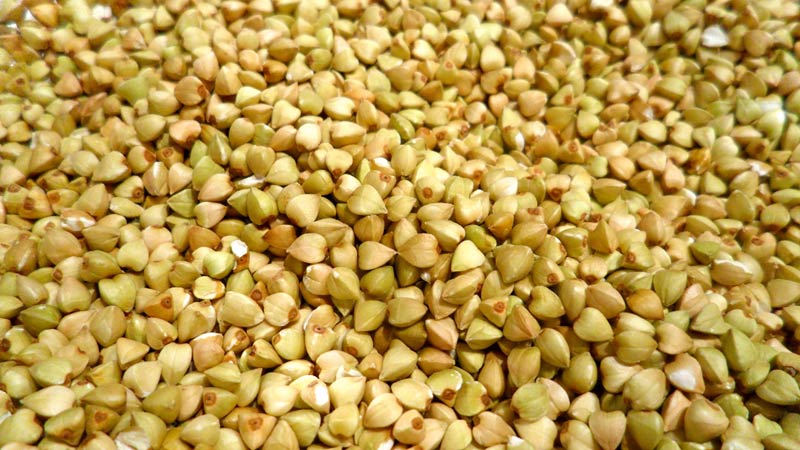
The nutritional value
Green buckwheat is a valuable source of minerals, vitamins and amino acids. Vegetarians get protein from it.
Cereals are rich in fiber.Green buckwheat is easily digestible and keeps you feeling full for a long time.
Mineral composition, vitamins, amino acids
Green buckwheat contains:
- iron - 6.5 mg;
- calcium - 20.5 mg;
- potassium - 379 mg;
- phosphorus - 295 mg;
- iodine - 3.2 mcg;
- zinc - 1.9 mg;
- magnesium - 198 mg;
- sodium - 1.0 mg;
- fluoride - 22 mcg;
- copper - 1.1 mg;
- manganese - 1.3 mg;
- selenium - 8.3 mcg.
The amount of vitamins per 100 g is also impressive:
- B vitamins - 1.32 mg;
- vitamin A - 5.9 mcg;
- vitamin E - 6.6 mg;
- nicotinic acid (PP) - 4.1 mg.
Cereals contain a complex of three essential amino acids for humans: leucine, isoleucine and valine.
Important! Amino acid deficiency leads to weakened memory, mental abilities and decreased immunity.
It is precisely because of the record amount of minerals, vitamins and amino acids in its composition that buckwheat is called the queen of cereals.
Calorie content, BJU, glycemic index
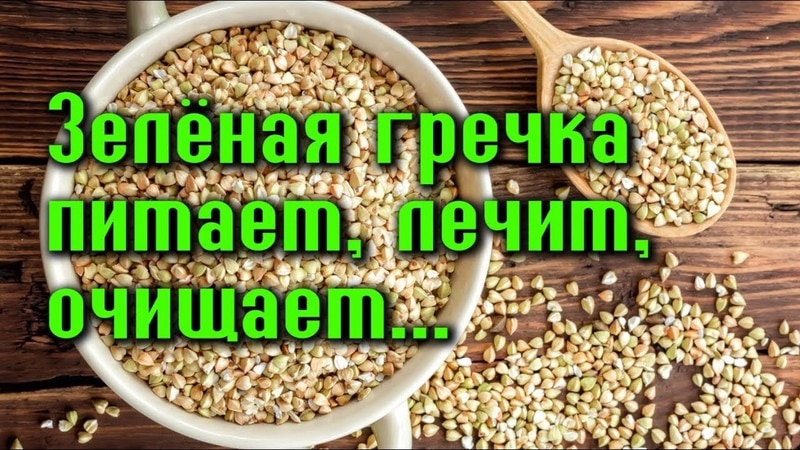
The calorie content of a green kernel is lower than that of a brown one: 310 kcal and 335 kcal, respectively.
In terms of protein content per 100 g of product, green is superior to brown: 14 g and 12 g, respectively. The fat content is approximately the same - 2 g and 3 g, carbohydrates - 60 g and 64 g.
Important! Neither brown nor green grains contain gluten or cholesterol.
According to the glycemic index, brown buckwheat loses to green buckwheat. The glycemic index is an indicator of the effect of carbohydrates on changes in blood sugar levels. Carbohydrates with a glycemic index of 55 or lower are absorbed more slowly by the body and cause a smaller, slower rise in blood sugar.
If you often consume foods with a high glycemic index, your body's metabolic processes are disrupted. This leads to excess weight. We get a lot of energy from carbohydrates.Carbohydrates are divided into fast and slow. The former have a high glycemic index, the latter - low.
The glycemic index of green cereals is 50 units, brown – 60. Both types are classified as slow carbohydrates. But the glycemic index makes the former more suitable for dietary nutrition.
Which buckwheat is healthier - green or regular?
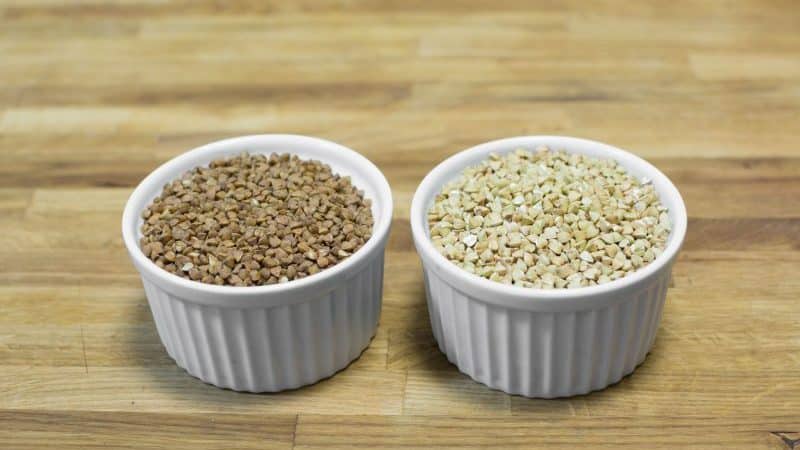
The benefits and harms of buckwheat are an important issue for supporters of a healthy diet. The brown kernel is inferior to the green one in the amount of nutrients. It contains vitamins, microelements, and amino acids, but in a smaller composition than in unprocessed cereals. As a result of heat treatment, a significant part is lost useful substances, necessary for a person, but taste improves.
Reference. During heat treatment, harmful microorganisms die and the shelf life of the product increases.
Buckwheat contains rutin (vitamin P). This is a substance that improves blood movement. The main “keeper” of vitamin P is the grain shell. It contains 17 times more routine than inside the core. It is this that colors the buckwheat grain green. During heat treatment, rutin is destroyed. Only its minimal content remains inside the nucleus. The high content of rutin is another argument in favor of green buckwheat.
Green kernels are called a dietary and healthy product. This cereal is easily digestible and has preventive, restorative and cleansing properties.
Its regular (2-3 times a week) use:
- improves blood circulation;
- has a beneficial effect on the functioning of the gastrointestinal tract, removes toxins and waste;
- has a positive effect on metabolism;
- strengthens the immune system;
- regulates cholesterol and blood sugar levels;
- normalizes blood pressure;
- prevents cancer;
- improves the condition of hair and nails;
- helps in the treatment of acne;
- normalizes weight;
- prevents the development of senile sclerosis and heart problems;
- improves the functioning of the nervous system.
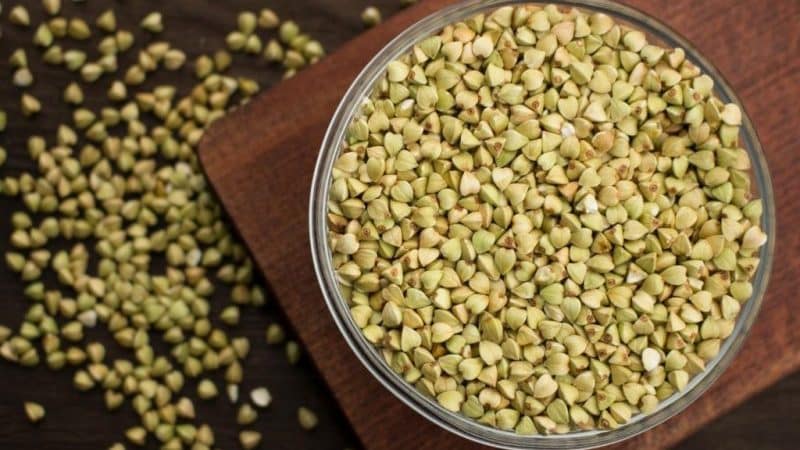
Green buckwheat is rich in fiber. 100 g of this cereal contains 10%. This is 1.5-2 times more than in millet, oats, rice and pearl barley!
Important! Fiber removes cholesterol from the body and reduces the risk of cardiovascular diseases.
The only contraindication to consuming both types of cereals is individual intolerance.
How to properly cook green buckwheat
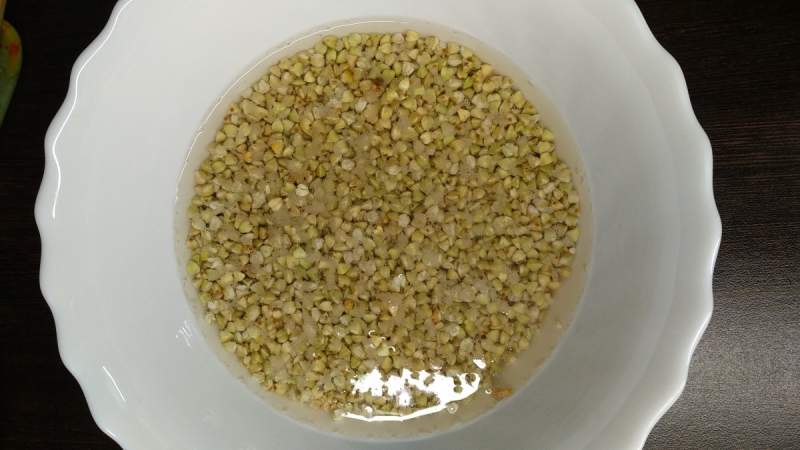
Sprouted and raw buckwheat is most useful, but most often it is eaten boiled.
Features of boiling and eating raw
Boiled buckwheat is delicious with butter and vegetable oil. It is added to the finished porridge before eating.
To prepare boiled buckwheat:
- Fill the cereal with water (1:2).
- Bring to a boil.
- Remove from the stove and check that the lid is tightly closed.
- In 30 minutes, buckwheat porridge will be ready. The less it is cooked, the more useful it remains.
Preparing buckwheat for consumption raw does not take much time:
- In the evening, pour warm water over the cereal.
- Cover with a plate and leave overnight.
In the morning you will receive crumbly, tasty porridge without heat treatment. Another recipe option: in the evening, fill the core with kefir 0.5% or 1% fat.
Grind raw buckwheat in a coffee grinder. Add the resulting powder to smoothies, pancake and pancake batter. Chopped cereal is good for making buckwheat soup. It is useful for exacerbation of gastrointestinal diseases, when thoroughly crushed or pureed food is required.
Buckwheat noodles (nihonsoba) are a national dish of Japan.Its color is brown-gray.
To prepare nihonsoba:
- Mix buckwheat flour with wheat flour.
- Add salt and water.
- Roll out the dough thinly and cut into narrow strips.
- Add the water in which the buckwheat noodles were cooked to the sauce or drink after eating. Buckwheat broth is also rich in nutrients.
Germination
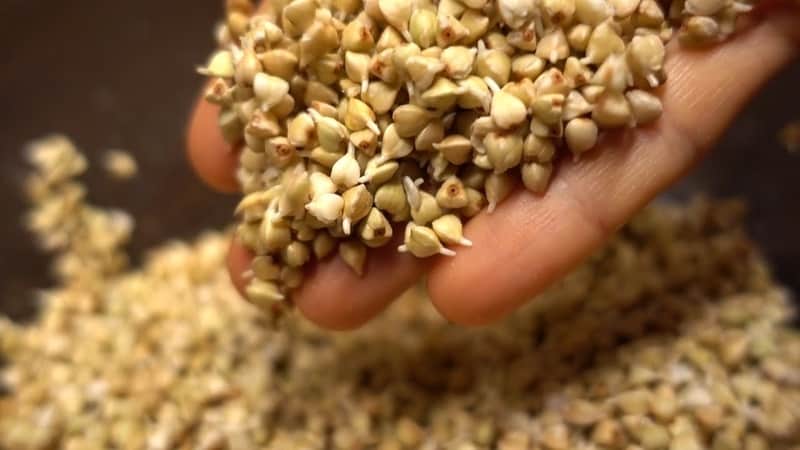
The germination method without using a gauze pad includes the following steps:
- Rinse the cereal.
- Soak for 40 minutes in any water other than tap water. During this time, the cereal will be sufficiently saturated with water.
- Drain thoroughly and cover with a lid. Do not use a metal container for germination.
- Leave for 14-24 hours. Rinse before eating.
Sprouting cereals using a gauze napkin is a labor-intensive method, but for many healthy food lovers it is more familiar:
- Rinse the core.
- Place the grains on a gauze cloth and then in a colander.
- Cover the top with three more layers of gauze and pour running purified water on top. Make sure it is glassed well.
- Place the colander in a dark place for 8 hours. During this time, the sprouts will hatch.
- Then wet the napkin again. Leave the sprouts for another 6 hours under the same conditions.
- Remove the sprouted buckwheat from the gauze. Rinse thoroughly.
Sprouted buckwheat is added to any salad or eaten as an independent dish.
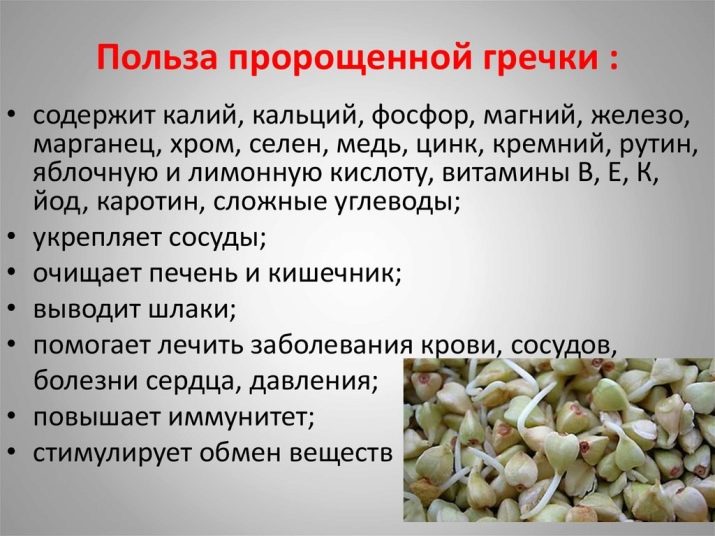
Read also:
Instructions for buyers: how to choose buckwheat correctly.
Conclusion
Which color of buckwheat is healthier? The answer is clear: green. “Live” cereal that easily sprouts at home has a high nutritional value. And all thanks to the lack of heat treatment.Green buckwheat is called the queen of cereals. This is a favorite product of people who follow a healthy diet. Eat buckwheat with pleasure!